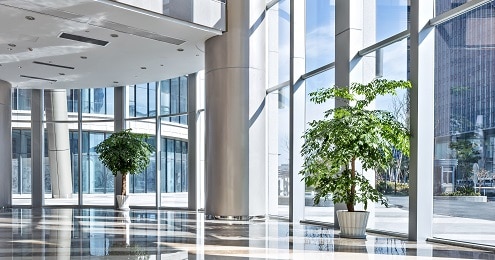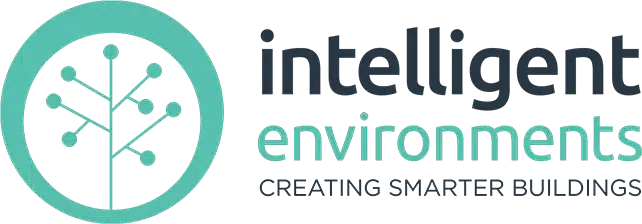It is an expectation today that a corporate office building will include a control system to enhance energy efficiency, support sustainability goals, and maintain employee comfort and well-being.
Innovative wireless technology also means that office lighting control systems are not restricted to new builds, or substantial renovations. Systems can now be installed or expanded with very little disruption to existing infrastructure, and without major inconvenience to those working in the building.

Even the most basic of office lighting control systems should be able to automatically adjust lighting based on occupancy, natural light levels, and time of day, reducing unnecessary energy consumption and lowering operating costs.
Additionally, well-regulated lighting can create a more comfortable and flexible work environment, promoting concentration and reducing eye strain.
As sustainability becomes increasingly important, lighting control systems are essential in meeting energy codes and environmental standards, making them a critical component of any modern office building.
Although some level of control can be provided ‘standalone’ via sensors, for enhanced benefits a full control system is required. This allows such elements as ‘corridor linking’ for improved employee safety and security. Corridor linking provides safe pathways of light to be provided between the area where an employee may be working after hours, and the exit to the floor or building. Or perhaps the area where an employee is working is fully lit, but adjacent areas are lit to a low level. Balancing the need between energy saving, and employee safety.
Additionally, the system can be programmed to function differently according to the time of day. Lighting may be ‘scheduled’ for example, to turn on/off at certain times on workdays, but outside of normal working hours, may turn on only when occupancy is sensed, turning off when the area is no longer occupied.
Design Considerations
The following factors will need to be considered:
-
- Size of each space/room/area
- Type of office (cubicle or open plan)
- Number of workspaces
- Availability of windows, skylights, other sources of natural light
The required controls will vary according to the needs of each space, for example:
Individual Offices/Meeting Rooms
Enclosed offices or small meeting rooms will likely have a single table, desk, and a few chairs. It is unlikely there will be people frequently entering and leaving the room. Lighting over the desk or table will need to keep occupants alert and active, but lighting above the seating should reduce glare from screens.
The controls should allow for:
-
-
-
- ‘Task-tuning’ of the lighting to enhance user comfort.
- Absence sensing to maximise energy saving.
- Corridor linking of adjacent areas for staff security and safety, plus reduced energy consumption.
- Daylight harvesting, natural daylight boosts productivity, as well as reduces energy consumption.
-
-
Control can be provided via the wider building or tenancy control system, or via standalone control for the individual room.
Open Plan Offices
It is likely any open plan offices will contain anything from a small number of desks with minimal partitions, to long rows of desks within cubicles.
There will also be circulation areas to allow movement through, to and from the area, and possibly service areas for photocopying, kitchen areas, and perhaps lounges with couches.
The desks will benefit from cool lighting to keep employees active and on task, but the circulation and relaxing spaces would be better with warm lighting. Automated lighting control can save energy, but also enhances safety.
The controls should allow for:
-
-
-
- Task-lighting for alertness and user comfort.
- Occupancy sensing for energy saving and security.
- Scheduling for convenience, security and staff comfort. Functionality turns on/off according to schedule, returns to occupancy/absence detection as above when someone is present outside of office hours.
- Corridor linking of adjacent areas for staff security and safety, plus reduced energy consumption.
- Daylight sensing to improve concentration, productivity and enhanced energy savings.
-
-
Boardrooms / Conference Rooms
Boardrooms or conference/large meeting rooms are important places for businesses. Commonly it’s where ideas are formed, information is shared and decision making happens. It is likely the space will contain audio-visual equipment, whiteboards or digital displays, tables and seating.
The lighting should create a professional ambience that also fosters ideas and creativity. Different lighting will be required for seating areas, and for screens, whiteboards and digital displays. Ideally the lighting and blinds will integrate with the audio-visual controls e.g. turning on the screen or projector also dims the lights and draws the blinds.
The controls should allow for:
-
-
- Flexible light scenes for the different uses the area will need to accommodate.
- Occupancy/Absence sensing for energy saving.
- Daylight sensing to improve concentration and creative thinking, and to enhance energy savings.
-
In some instances, larger conference rooms are also used as several smaller areas when partitioning is in place. In such situations controls can be programmed to allow the area to work seamlessly as one large space or be controlled separately as individual areas when divided.
Corridors
Corridors have extremely variable occupancy patterns but are a major cause of energy inefficiency when lights are left burning at full level all the time. Continuous lighting is rarely necessary but when someone passes through the space, they should feel secure and safe.
Corridor linking is discussed above, and this is an important benefit offered by a control system that can ensure no-one exits a well-lit area to move into a dark space, with those inherent dangers.
As a staff member enters a stairwell to exist a multi-level building for example, the lights on the stairs above and below their current level remain on, shepherding them safely to the exit, with the car park lights coming on before that area is reached.
The controls should allow for:
-
-
- Occupancy/absence detection for energy saving.
- Scheduling for convenience, security and staff comfort. Functionality turns on/off according to schedule, returns to occupancy/absence detection as above when someone is present outside of office hours.
- Corridor linking of adjacent areas for staff security and safety, plus reduced energy consumption.
- Daylight sensing where possible for enhanced energy savings.
-
Lobby
The lobby may be the entrance or reception, or an area by the lifts, or simply the transition between different office spaces. Such areas should be welcoming, and secure.
Rather than have lobby areas in darkness when unoccupied, the preference is often to have the lights in the area come on at a lower level, then ramp up to full brightness when someone moves into the area. In a lift lobby for example, it would be disconcerting and feel unsafe if the lift doors opened to an area that was unlit. This works in a similar way to corridor linking.
The controls should allow for:
-
-
- Occupancy/absence detection for energy saving, dropping lights to a lower level.
- Scheduling for convenience, security and staff comfort. Functionality turns on/off according to schedule, returns to occupancy/absence detection as above when someone is present outside of office hours.
- Corridor linking of adjacent areas for staff security and safety, plus reduced energy consumption.
- Daylight sensing where possible for enhanced energy savings.
-
Emergency Lighting Control
Incorporating emergency lighting into your control system will ensure compliance and maintenance becomes cost effective and simplified.
The system will schedule and automate the necessary testing and reporting of emergency lights, and ensure the relevant personnel are informed of any issues that require attention.
Dashboards for Monitoring and Compliance
Optimise building operations with zencontrol customised dashboards with advanced reports and analytics which provide visual representation of occupancy patterns, energy utilisation, and device operation. Faults can be easily identified, with a full warranty and service history to hand.
New Fit-Outs
Your electrical contractor will be pleased to learn you will be incorporating a DALI-2 control system in your new building or fit out.
Wiring for a DALI-2 system is very simple. A standard 2-core low voltage cable is all that is needed to run both power and communication between the DALI devices. The DALI cable can also be run with the mains cable. It doesn’t need to be shielded.
DALI-2 also allows for flexible wiring topologies, including star, linear, or tree configurations. Only loop configurations need to be avoided.
By using DALI you are also complying with the AU/NZ standard for lighting control.
Upgrades to Existing Offices
If cables are being run for lighting, power, etc we would always recommend that DALI cabling be installed at the same time. However, if the upgrade is extending an existing system, or if you are upgrading without major renovation, then DALI+ (wireless DALI) may be the preferred solution. It can work seamlessly with an existing DALI wired system or operate as a standalone system in its own right, with all the operability and functionality of a wired DALI-2 system, while still meeting the requirements of the AS/NZS62386 lighting control standard.
Free Consultation New Zealand Wide
If you are comparing office lighting control systems, we encourage you to take advantage of our free consultation to understand what is achievable for your building and your budget.


